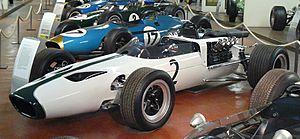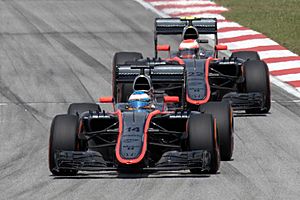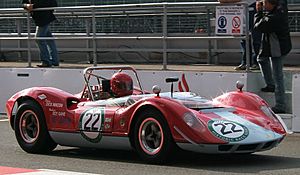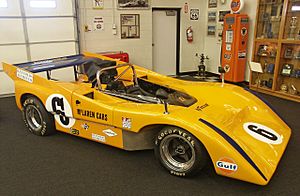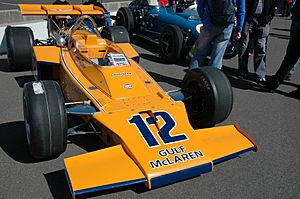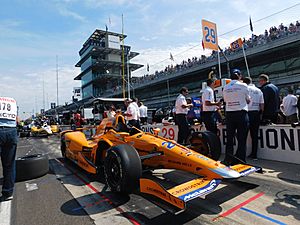McLaren facts for kids
 |
|
| Full name | McLaren Formula 1 Team |
|---|---|
| Base | McLaren Technology Centre Woking, Surrey, England |
| Team principal(s) | Andrea Stella (Team Principal) Zak Brown (Chief Executive Officer) |
| Technical management | Rob Marshall (Chief Designer) Neil Houldey (Technical Director, Engineering) Peter Prodromou (Technical Director, Aerodynamics) Mark Temple (Technical Director, Performance) |
| Founder(s) | Bruce McLaren |
| Website | mclaren.com/racing/formula-1 |
| Formula One World Championship career | |
| First entry | 1966 Monaco Grand Prix |
| Last entry | 2025 Singapore Grand Prix |
| Races entered | 884 (880 starts) |
| Engines | Ford, Serenissima, BRM, Alfa Romeo, TAG, Honda, Peugeot, Mercedes, Renault |
| Constructors' Championships |
10 (1974, 1984, 1985, 1988, 1989, 1990, 1991, 1998, 2024, 2025) |
| Drivers' Championships |
12 (1974, 1976, 1984, 1985, 1986, 1988, 1989, 1990, 1991, 1998, 1999, 2008) |
| Race victories | 182 |
| Podiums | 488 |
| Points | 5555.5 |
| Pole positions | 155 |
| Fastest laps | 158 |
| 2024 position | 1st (666 pts) |
McLaren Racing Limited is a famous British motor racing team. It is based in Woking, England, and is a big part of the McLaren Group. McLaren is best known for its Formula One cars. It is one of the oldest and most successful teams in Formula One history. The team has won many races and championships.
McLaren is also one of only three teams to achieve the "Triple Crown of Motorsport". This means they have won three very important races: the Indianapolis 500, the 24 Hours of Le Mans, and the Monaco Grand Prix.
The team was started in 1963 by Bruce McLaren. They won their first Grand Prix race in 1968. McLaren also had great success in other racing series, like Can-Am and American open-wheel racing. Over the years, many legendary drivers have raced for McLaren, helping them win many titles.
Contents
- Team Origins and Early Years (1963-1967)
- Formula One Racing: A Journey of Speed
- First Victories with Ford-Cosworth (1968–1982)
- Championship Glory and New Leadership (1973–1981)
- The Golden Era: TAG-Porsche and Honda Power (1983–1992)
- Engine Changes and New Challenges (1993–2014)
- Honda Return and Renault Engines (2015–2020)
- Back with Mercedes Power and Recent Success (2021–Present)
- Racing Beyond Formula One
- Team Structure and Identity
- McLaren Race Cars
- Racing Achievements
- Images for kids
- See also
Team Origins and Early Years (1963-1967)
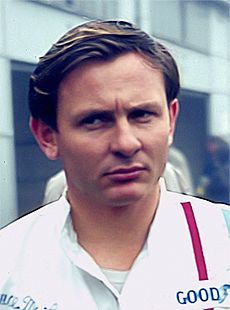
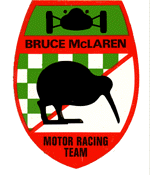
The McLaren team was founded in 1963 by Bruce McLaren from New Zealand. Bruce was already a successful driver for another British Formula One team, Cooper. He wanted to race in the Tasman Series in Australia and New Zealand. When his team wouldn't use the engines he wanted, Bruce decided to start his own team.
Bruce won the 1964 Tasman Series. Sadly, his teammate Timmy Mayer died in an accident that year. Bruce then partnered with Teddy Mayer to grow the team.
The team raced under a British license. Their first base was in Feltham, England. Later, they moved to Colnbrook and then to Woking. Bruce chose unique car colors instead of the traditional British racing green. For example, his first Formula One car was white with a green stripe.
Bruce continued to race his own cars in 1966. He made the team's Formula One debut at the 1966 Monaco Grand Prix. His car had engine problems and had to stop early. The first cars, like the McLaren M2B, struggled with engines that weren't powerful or reliable enough. For 1967, they tried different engines, but success was still hard to find.
Formula One Racing: A Journey of Speed
First Victories with Ford-Cosworth (1968–1982)
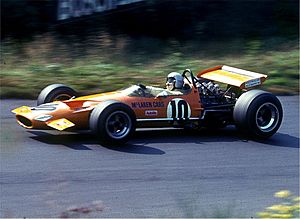
In 1968, Bruce was joined by fellow New Zealander Denny Hulme. Their new McLaren M7A car used the powerful Ford-Cosworth DFV engine. Bruce won the team's first championship race at the 1968 Belgian Grand Prix. Hulme also won two races that year. The team finished second in the Constructors' Championship.
Sadly, in June 1970, Bruce McLaren died in a testing accident. Teddy Mayer took over the team. In 1972, Hulme won a Grand Prix in South Africa. The team started to improve.
Championship Glory and New Leadership (1973–1981)
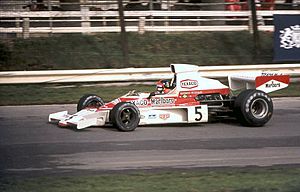
The McLaren M23 car was introduced in 1973 and became a very successful car. In 1974, Emerson Fittipaldi joined McLaren and won the Drivers' Championship. With Hulme and other drivers, McLaren also won its first Constructors' Championship.
In 1976, James Hunt joined the team. He had a thrilling battle with Niki Lauda and won the Drivers' Championship in the final race. However, the team lost the Constructors' Championship to Ferrari. After this, results became more difficult for McLaren.
In 1981, McLaren merged with Ron Dennis's Project Four Racing team. Ron Dennis became the team principal. This merger brought new ideas, including a revolutionary car made from carbon-fibre, the McLaren MP4/1. This car helped John Watson win the British Grand Prix.
The Golden Era: TAG-Porsche and Honda Power (1983–1992)
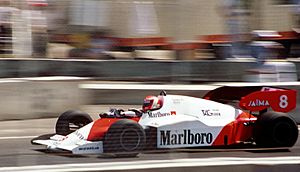
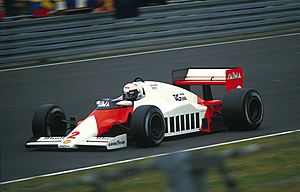
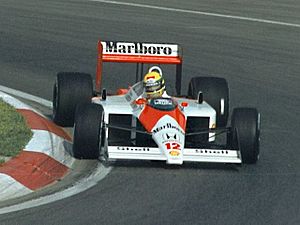
In the 1980s, turbocharged engines became popular. McLaren partnered with TAG and Porsche to create their own turbo engines. In 1984, Niki Lauda returned to McLaren and won the Drivers' Championship by a tiny half-point over his teammate Alain Prost. McLaren also won the Constructors' Championship.
In 1985 and 1986, Alain Prost won back-to-back Drivers' Championships. This was a very successful period for the team.
For 1988, Honda supplied powerful engines to McLaren. Ayrton Senna joined Prost, creating a dream team. They won 15 out of 16 races that year! Senna won his first world championship after a close battle with Prost. Their rivalry continued in 1989, with Prost winning the title.
McLaren and Senna continued their winning streak in 1990 and 1991, securing more Drivers' and Constructors' Championships. By 1992, other teams caught up, and McLaren's dominance ended.
Engine Changes and New Challenges (1993–2014)
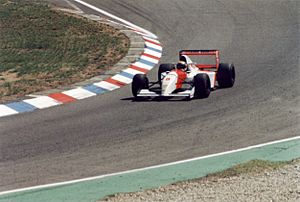

After Honda left, McLaren used Ford engines in 1993. Senna won five races, including a record sixth victory at Monaco. In 1994, they switched to Peugeot engines, but these were unreliable.
In 1995, McLaren began a long partnership with Mercedes-Benz for their engines. This brought new hope. In 1997, David Coulthard broke the team's winless streak. Highly talented designer Adrian Newey also joined.
In 1998, with new rules and Newey's designs, McLaren became champions again. Mika Häkkinen won the Drivers' Championship, and McLaren won the Constructors' Championship. Häkkinen won his second title in 1999.
During the 2000s, McLaren remained a strong team. In 2007, Fernando Alonso and rookie Lewis Hamilton raced together. There were some disagreements within the team. McLaren was also involved in a dispute over confidential car designs. The team was penalized, but Hamilton still fought for the championship.
In 2008, Lewis Hamilton won his first Drivers' Championship in a dramatic final race. Ron Dennis then retired as team principal, and Martin Whitmarsh took over. In 2010, Jenson Button joined Hamilton. They both won races, but McLaren finished second in the Constructors' Championship.
From 2010 to 2014, Mercedes continued to supply engines to McLaren. The team had some wins but struggled to consistently challenge for championships.
Honda Return and Renault Engines (2015–2020)
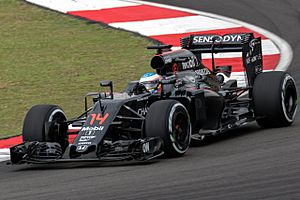
In 2015, McLaren reunited with Honda for their engines. This partnership was difficult, with the cars often lacking power and reliability. Fernando Alonso and Jenson Button faced many challenges.
The team's performance slowly improved in 2016. In 2017, McLaren finished ninth in the Constructors' Championship. Alonso even raced in the Indianapolis 500 that year.
In 2018, McLaren switched to Renault engines. Alonso and Stoffel Vandoorne raced for the team. The season was still tough, but the team started to show signs of improvement. In 2019, with Carlos Sainz Jr. and Lando Norris, McLaren had a much better year. Sainz achieved the team's first podium finish in a long time.
In 2020, Norris achieved his first podium, and Sainz secured another. McLaren finished third in the Constructors' Championship, showing great progress.
Back with Mercedes Power and Recent Success (2021–Present)
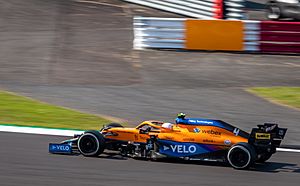
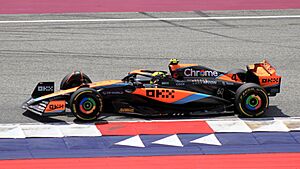

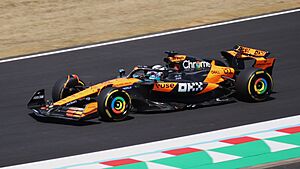
McLaren returned to using Mercedes engines in 2021. Daniel Ricciardo joined Lando Norris. Ricciardo won the 2021 Italian Grand Prix, giving McLaren its first win in many years. Norris also achieved his first pole position.
In 2022, Norris continued to perform well, securing a podium finish. Ricciardo struggled, and Oscar Piastri joined the team for 2023 after an agreement was reached about the driver.
The 2023 season marked McLaren's 60th anniversary. After a challenging start, the team introduced major car upgrades. These upgrades quickly improved performance. Norris achieved a podium, and Piastri won a sprint race and his first career podium. McLaren also set a new record for the fastest pit stop. The team finished fourth in the Constructors' Championship.
The 2024 season was incredibly successful for McLaren. The McLaren MCL38 car was very competitive. Lando Norris achieved his first Formula One victory at the Miami Grand Prix. The team continued to improve, securing a 1-2 finish in Hungary. Piastri's win in Azerbaijan helped McLaren take the lead in the Constructors' Championship. In Abu Dhabi, Norris won, and McLaren secured their ninth Constructors' Championship, their first since 1998.
In 2025, McLaren continued its winning momentum. The McLaren MCL39 car, overseen by Rob Marshall, showed immediate advantages. As of the Singapore Grand Prix, McLaren had won twelve out of eighteen races, including seven 1-2 finishes. This success led to McLaren securing their tenth Constructors' Championship, making them the most successful independent Formula One constructor.
Racing Beyond Formula One
Can-Am: Dominating Sports Car Racing
McLaren's first car designed and built by the team was the M1 sports car in 1964. It was very successful. In 1966, the Can-Am Series began, a championship for powerful sports cars. McLaren created the M3, but didn't win the title that year.
In 1967, McLaren designed the McLaren M6A, painted in their famous orange color. Bruce McLaren and Denny Hulme dominated, winning five of six races. Bruce won the championship. This success continued for four more years. In 1969, McLaren won all 11 races with the M8B car.
Can-Am success brought a lot of money to McLaren. This helped fund their growing Formula One team. McLaren eventually left Can-Am in 1972 to focus on Formula One. They were the most successful constructor in Can-Am history with 43 wins.
American Open-Wheel Racing: Indy 500 Victories
McLaren first raced in the Indianapolis 500 in 1970. They wanted to challenge other tire companies. In 1972, a private team won the Indy 500 with a McLaren M16B car.
McLaren won its first Indianapolis 500 in 1974 with Johnny Rutherford. He won again in 1976. McLaren stopped racing in USAC (United States Auto Club) events by the end of 1979 to focus on Formula One.
In 2017, McLaren returned to the Indianapolis 500 with Fernando Alonso. Alonso led many laps but had to retire due to an engine problem. In 2019, they tried again but failed to qualify.
IndyCar Series: A Full-Time Return
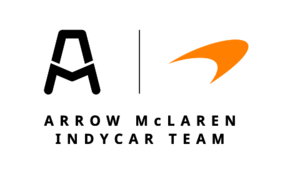 |
|
| Owner(s) | McLaren Racing Limited |
|---|---|
| Principal(s) | Zak Brown (Chairman) Brian Barnhart (General Manager) Tony Kanaan (Team Principal) |
| Base | Indianapolis, Indiana, United States |
| Series | IndyCar Series |
| Race drivers | 5. 6. 7. |
| Sponsors | Arrow Electronics, Lucas Oil, Vuse and NTT Data |
| Manufacturer | Chevrolet |
| Career | |
| Debut | 2020 Genesys 300 |
| Latest race | 2021 Honda Indy 200 (Mid-Ohio) |
| Race victories | 6 |
| Pole positions | 9 |
In 2019, McLaren announced they would race full-time in the IndyCar Series starting in 2020. They partnered with Arrow Schmidt Peterson Motorsports to form Arrow McLaren SP. This move aimed to promote the McLaren brand in North America.
In 2021, McLaren Racing bought a majority share of the IndyCar team. The team has seen success with drivers like Pato O'Ward and Felix Rosenqvist. In 2023, the team raced with special liveries at the Indianapolis 500 to celebrate McLaren's Triple Crown wins.
Electric Racing: New Frontiers
McLaren has also ventured into electric motorsport. They entered the Extreme E series in 2022. This is an off-road racing series for electric SUVs. The team achieved its first podium in 2022. They continued to compete in 2023 and 2024.
Formula E: Electric Single-Seaters
 |
|
| Base | McLaren Technology Centre Woking, Surrey, England Bicester Motion Bicester, Oxfordshire, England |
|---|---|
| Former series | Formula E |
| Noted drivers | |
In 2022, McLaren acquired the Mercedes-EQ Formula E Team. They debuted in the 2022–23 Formula E World Championship as NEOM McLaren Formula E Team. Jake Hughes secured McLaren's first pole position and René Rast achieved their first podium.
In the 2023–24 season, Sam Bird won McLaren's first electric race victory. Young driver Taylor Barnard also made history as the youngest driver to start an ePrix. McLaren announced they would exit Formula E at the end of the 2024–25 season to focus on other racing plans.
Endurance Racing: Le Mans Hypercar Plans
McLaren has been exploring entering the FIA World Endurance Championship (WEC) Hypercar class. In 2024, CEO Zak Brown announced plans for a Hypercar entry. In 2025, McLaren confirmed they will enter the WEC in the Hypercar class starting from the 2027 season. They will partner with United Autosports and Dallara.
Customer Racing: Cars for Other Teams
Besides their own race cars, McLaren has also built cars for other teams. In their early years, they sold Formula Two and sports racing cars. Many teams used McLarens in Can-Am and Formula One.
In the 1990s, McLaren Cars built a racing version of their McLaren F1 road car, the McLaren F1 GTR. This car famously won the 1995 24 Hours of Le Mans. More recently, McLaren has developed GT3 and GT4 versions of their road cars for customer teams. In 2023, McLaren Automotive announced plans to participate in the 2024 24 Hours of Le Mans with customer teams.
Team Structure and Identity
Ownership and Leadership
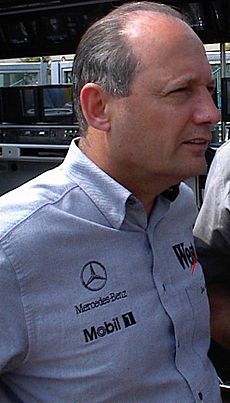
McLaren Racing is mostly owned by the McLaren Group. In 1981, Ron Dennis took full control of the team. He later partnered with Mansour Ojjeh. Mercedes-Benz also owned a part of the team for a while.
Ron Dennis stepped down as team principal in 2009. Martin Whitmarsh took over. After some difficult years, Dennis returned in 2014. However, disagreements led to his departure in 2016. Zak Brown became the McLaren Racing CEO. In 2019, Andreas Seidl was appointed team principal. In 2022, Andrea Stella became the new team principal.
Since 2004, the team has been based at the McLaren Technology Centre in Woking, England. This facility has advanced tools like a wind tunnel and a driving simulator. McLaren also has a program to develop young drivers.
Team Politics and Fair Play
McLaren has sometimes had disagreements with the FIA, the governing body of Formula One. In the early 1980s, they were part of a dispute with racing authorities over control of the sport. This was eventually resolved with an agreement.
In 2007, McLaren was involved in a dispute over confidential technical information from another team. McLaren was penalized and fined. However, the team has worked to maintain good relationships with the sport's authorities in recent years.
Sponsorship, Colors, and Car Names
In 1972, Yardley of London became McLaren's first main sponsor, changing the car's colors to white. In 1974, a new sponsor brought a famous red-and-white design that lasted until 1996. This was one of the longest sponsorships in Formula One.
In 1997, a new sponsor, West, led to McLaren adopting a silver and black livery. Due to rules about advertising, McLaren raced without a main sponsor in 2006. They then partnered with Vodafone in 2007, which brought a new look.
Since 2018, McLaren has raced as McLaren Formula 1 Team. CEO Zak Brown decided not to sell the team's name to a single sponsor. Instead, they work with many major sponsors like British American Tobacco (for their "A Better Tomorrow" campaign), Gulf Oil International, Google, OKX, and Mastercard. In 2025, Mastercard became a major partner, and the team will be known as McLaren Mastercard Formula 1 Team from 2026.
McLaren's cars first used an orange design, called papaya orange, from 1968 to 1971. This color is now their traditional team color. Since 2017, McLaren has returned to using papaya orange on their cars. They also use special liveries (car designs) for certain races or to celebrate events, often with their sponsors.
McLaren's cars were originally named with "M" and a number. After the 1981 merger, they became "MP4/x" or "MP4-x". "MP4" stood for "Marlboro Project 4" and later "McLaren Project 4". Since 2017, the cars are named "MCL" followed by a number, like the McLaren MCL60 for their 60th anniversary in 2023.
McLaren Race Cars
McLaren designs and builds many of its own race cars. The most successful McLaren Formula One car is the McLaren MP4/4 from 1988. This car, driven by Ayrton Senna and Alain Prost, won almost every race that season.
Racing Achievements
Formula One Results
- Constructors' Championships won: 10
- Drivers' Championships won: 12
- Race wins: 182
| Formula One results | ||||||||
|---|---|---|---|---|---|---|---|---|
| (italics indicates non-works entries; bold indicates championships won) | ||||||||
| Year | Name | Car | Engine | Tyres | No. | Drivers | Points | WCC |
| 1966 | M2B | Ford 406 3.0 V8 Serenissima M166 3.0 V8 |
F | N/A | 2 1 |
9th 12th |
||
| 1967 | M4B M5A |
BRM P56 2.0 V8 BRM P142 3.0 V12 |
G | N/A | 3 | 10th | ||
| 1968 | M5A M7A |
BRM P142 3.0 V12 Ford-Cosworth DFV 3.0 V8 |
G | N/A | 3 49 |
10th 2nd |
||
| 1969 | M7A M7B M7C M9A |
Ford-Cosworth DFV 3.0 V8 | G | N/A | 38 (40) | 5th | ||
| 1970 | M7D M14A M14D |
Ford-Cosworth DFV 3.0 V8 Alfa Romeo T33 3.0 V8 |
G | N/A | 35 0 |
5th NC |
||
| 1971 | M14A M19A |
Ford-Cosworth DFV 3.0 V8 | G | N/A | 10 | 6th | ||
| 1972 | M19A M19C |
Ford-Cosworth DFV 3.0 V8 | G | N/A | 47 (49) | 3rd | ||
| 1973 | M19A M19C M23 |
Ford-Cosworth DFV 3.0 V8 | G | N/A | 58 | 3rd | ||
| 1974 | M23 | Ford-Cosworth DFV 3.0 V8 | G | 5. 6. 33. 33. 33. |
73 (75) | 1st | ||
| 1975 | M23 | Ford-Cosworth DFV 3.0 V8 | G | 1. 2. |
53 | 3rd | ||
| 1976 | M23 M26 |
Ford-Cosworth DFV 3.0 V8 | G | 11. 12. |
74 (75) | 2nd | ||
| 1977 | M23 M26 |
Ford-Cosworth DFV 3.0 V8 | G | 1. 2. 14. 40. |
60 | 3rd | ||
| 1978 | M26 | Ford-Cosworth DFV 3.0 V8 | G | 7. 8. 33. |
15 | 8th | ||
| 1979 | M26 M28 M28B M28C M29 |
Ford-Cosworth DFV 3.0 V8 | G | 7. 8. |
15 | 7th | ||
| 1980 | M29B M29C M30 |
Ford-Cosworth DFV 3.0 V8 | G | 7. 8. 8. |
11 | 9th | ||
| 1981 | M29C M29F MP4 |
Ford-Cosworth DFV 3.0 V8 | M | 7. 8. |
28 | 6th | ||
| 1982 | MP4B | Ford-Cosworth DFV 3.0 V8 | M | 7. 8. |
69 | 2nd | ||
| 1983 | MP4/1C MP4/1E |
Ford-Cosworth DFV 3.0 V8 TAG-Porsche 1.5 V6 t |
M | 7. 8. |
34 0 |
5th NC |
||
| 1984 | MP4/2 | TAG-Porsche 1.5 V6 t | M | 7. 8. |
143.5 | 1st | ||
| 1985 | MP4/2B | TAG-Porsche 1.5 V6 t | G | 1. 1. 2. |
90 | 1st | ||
| 1986 | MP4/2C | TAG-Porsche 1.5 V6 t | G | 1. 2. |
96 | 2nd | ||
| 1987 | MP4/3 | TAG-Porsche 1.5 V6 t | G | 1. 2. |
76 | 2nd | ||
| 1988 | MP4/4 | Honda RA168E 1.5 V6 t | G | 11. 12. |
199 | 1st | ||
| 1989 | MP4/5 | Honda RA109E 3.5 V10 | G | 1. 2. |
141 | 1st | ||
| 1990 | MP4/5B | Honda RA100E 3.5 V10 | G | 27. 28. |
121 | 1st | ||
| 1991 | MP4/6 | Honda RA121E 3.5 V12 | G | 1. 2. |
139 | 1st | ||
| 1992 | MP4/6B MP4/7A |
Honda RA122E 3.5 V12 Honda RA122E/B 3.5 V12 |
G | 1. 2. |
99 | 2nd | ||
| 1993 | MP4/8 | Ford HBE7 3.5 V8 | G | 7. 7. 8. |
84 | 2nd | ||
| 1994 | MP4/9 | Peugeot A6 3.5 V10 | G | 7. 7. 8. |
42 | 4th | ||
| 1995 | MP4/10 MP4/10B MP4/10C |
Mercedes FO 110 3.0 V10 | G | 7. 7. 8. 8. |
30 | 4th | ||
| 1996 | MP4/11 | Mercedes FO 110 3.0 V10 | G | 7. 8. |
49 | 4th | ||
| 1997 | MP4/12 | Mercedes FO 110E 3.0 V10 Mercedes FO 110F 3.0 V10 |
G | 9. 10. |
63 | 4th | ||
| 1998 | MP4/13 | Mercedes FO 110G 3.0 V10 | B | 7. 8. |
156 | 1st | ||
| 1999 | MP4/14 | Mercedes FO 110H 3.0 V10 | B | 1. 2. |
124 | 2nd | ||
| 2000 | MP4/15 | Mercedes FO 110J 3.0 V10 | B | 1. 2. |
152 | 2nd | ||
| 2001 | MP4-16 | Mercedes FO 110K 3.0 V10 | B | 3. 4. |
102 | 2nd | ||
| 2002 | MP4-17 | Mercedes FO 110M 3.0 V10 | M | 3. 4. |
65 | 3rd | ||
| 2003 | MP4-17D | Mercedes FO 110M 3.0 V10 Mercedes FO 110P 3.0 V10 |
M | 5. 6. |
142 | 3rd | ||
| 2004 | MP4-19 MP4-19B |
Mercedes FO 110Q 3.0 V10 | M | 5. 6. |
69 | 5th | ||
| 2005 | MP4-20 | Mercedes FO 110R 3.0 V10 | M | 9. 10. 10. 10. |
182 | 2nd | ||
| 2006 | MP4-21 | Mercedes FO 108S 2.4 V8 | M | 3. 4. 4. |
110 | 3rd | ||
| 2007 | MP4-22 | Mercedes FO 108T 2.4 V8 | B | 1. 2. |
0 (203) | EX | ||
| 2008 | MP4-23 | Mercedes FO 108T 2.4 V8 | B | 22. 23. |
151 | 2nd | ||
| 2009 | MP4-24 | Mercedes FO 108W 2.4 V8 | B | 1. 2. |
71 | 3rd | ||
| 2010 | MP4-25 | Mercedes FO 108X 2.4 V8 | B | 1. 2. |
454 | 2nd | ||
| 2011 | MP4-26 | Mercedes FO 108Y 2.4 V8 | P | 3. 4. |
497 | 2nd | ||
| 2012 | MP4-27 | Mercedes FO 108Z 2.4 V8 | P | 3. 4. |
378 | 3rd | ||
| 2013 | MP4-28 | Mercedes FO 108F 2.4 V8 | P | 5. 6. |
122 | 5th | ||
| 2014 | MP4-29 | Mercedes PU106A Hybrid 1.6 V6 t | P | 20. 22. |
181 | 5th | ||
| 2015 | MP4-30 | Honda RA615H 1.6 V6 t | P | 14. 20. 22. |
27 | 9th | ||
| 2016 | MP4-31 | Honda RA616H 1.6 V6 t | P | 14. 22. 47. |
76 | 6th | ||
| 2017 | MCL32 | Honda RA617H 1.6 V6 t | P | 2. 14. 22. |
30 | 9th | ||
| 2018 | MCL33 | Renault R.E.18 1.6 V6 t | P | 2. 14. |
62 | 6th | ||
| 2019 | MCL34 | Renault E-Tech 19 1.6 V6 t | P | 4. 55. |
145 | 4th | ||
| 2020 | MCL35 | Renault E-Tech 20 1.6 V6 t | P | 4. 55. |
202 | 3rd | ||
| 2021 | MCL35M | Mercedes M12 E Performance 1.6 V6 t | P | 3. 4. |
275 | 4th | ||
| 2022 | MCL36 | Mercedes M13 E Performance 1.6 V6 t | P | 3. 4. |
159 | 5th | ||
| 2023 | MCL60 | Mercedes M14 E Performance 1.6 V6 t | P | 4. 81. |
302 | 4th | ||
| 2024 | MCL38 | Mercedes M15 E Performance 1.6 V6 t | P | 4. 81. |
666 | 1st | ||
| 2025 | MCL39 | Mercedes M16 E Performance 1.6 V6 t | P | 4. 81. |
202* | 3rd | ||
| * Season still in progress. | ||||||||
| Source: | ||||||||
Drivers' Champions
Seven drivers have won a total of twelve Drivers' Championships with McLaren:
 Emerson Fittipaldi (1974)
Emerson Fittipaldi (1974) James Hunt (1976)
James Hunt (1976) Niki Lauda (1984)
Niki Lauda (1984) Alain Prost (1985, 1986, 1989)
Alain Prost (1985, 1986, 1989) Ayrton Senna (1988, 1990, 1991)
Ayrton Senna (1988, 1990, 1991) Mika Häkkinen (1998, 1999)
Mika Häkkinen (1998, 1999) Lewis Hamilton (2008)
Lewis Hamilton (2008)
Esports Racing Achievements
McLaren also competes in virtual racing, known as Esports. Their team, McLaren Shadow, has achieved great success.
* Season still in progress
Esports Drivers' Champions
The following driver won the Formula One Esports Drivers' Championship for McLaren Shadow:
Extreme E Results
| Year | Name | Car | Tyres | No. | G. | Drivers | Rounds | Pts. | Pos. |
|---|---|---|---|---|---|---|---|---|---|
| 2022 | NEOM McLaren Extreme E Team |
Spark Odyssey 21 | C | 58. | M | (1–5) | 52 | 5th | |
| F | (1–5) | ||||||||
| 2023 | Spark Odyssey 21 | C | 58. | M | (1–10) | 68 | 8th | ||
| F | (1–7) | ||||||||
| (7–8) | |||||||||
| (9–10) | |||||||||
| 2024 | Spark Odyssey 21 | C | 58. | M | (1–4) | 46 | 5th | ||
| F | (1–4) |
Formula E Results
| Year | Chassis | Powertrain | Tyres | No. | Drivers | 1 | 2 | 3 | 4 | 5 | 6 | 7 | 8 | 9 | 10 | 11 | 12 | 13 | 14 | 15 | 16 | Points | T.C. |
|---|---|---|---|---|---|---|---|---|---|---|---|---|---|---|---|---|---|---|---|---|---|---|---|
| NEOM McLaren Formula E Team | |||||||||||||||||||||||
| 2022–23 | Formula E Gen3 | Nissan e-4ORCE 04 | H | MEX | DRH | HYD | CAP | SAP | BER | MCO | JKT | POR | RME | LDN | 88 | 8th | |||||||
| 5 | 5 | 8 | 5 | Ret | 10 | 8 | Ret | 18 | 5 | 10 | Ret | 18 | DNS | 11 | 10 | 19 | |||||||
| 58 | Ret | 5 | 3 | Ret | 4 | 9 | 17 | 13 | 17 | 15 | 15 | 14 | Ret | 13 | 14 | 12 | |||||||
| 2023–24 | Formula E Gen3 | Nissan e-4ORCE 04 | H | MEX | DRH | SAP | TKO | ITA | MCO | BER | SHA | POR | LDN | 101 | 7th | ||||||||
| 5 | 7 | 11 | 4 | Ret | 14 | 13 | 8 | 16 | 15 | 12 | 16 | 2 | 21 | Ret | Ret | 10 | |||||||
| 8 | 14 | 4 | Ret | 1 | 19 | Ret | 10 | WD | 17 | Ret | 7 | Ret | 8 | Ret | |||||||||
| 14 | 10 | 8 | |||||||||||||||||||||
| 2024–25 | Formula E Gen3 Evo | Nissan e-4ORCE 04 | H | SAP | MEX | JED | MIA | MCO | TKO | SHA | JAK | BER | LDN | 143 | 6th | ||||||||
| 5 | 3 | 14 | 3 | 2 | 20 | 15 | 16 | 3 | Ret | 3 | 10 | 7 | 4 | 6 | 13 | Ret | |||||||
| 8 | 4 | 18 | 8 | 12 | 18 | 11 | 20 | 14 | 8 | 7 | 15 | 8 | 11 | Ret | NC | Ret | |||||||
Images for kids
See also
 In Spanish: McLaren para niños
In Spanish: McLaren para niños


